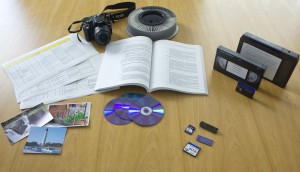 This page serves as a listing and access point for digitization standards I maintain and review for digital curation work at Rutgers University Libraries. The standards documents listed here are mirrored from the official digital standards listing on the Rutgers University Community Repository (RUcore) website.
This page serves as a listing and access point for digitization standards I maintain and review for digital curation work at Rutgers University Libraries. The standards documents listed here are mirrored from the official digital standards listing on the Rutgers University Community Repository (RUcore) website.
As these documents are reviewed and revised to adapt to changing trends and technologies, they will be updated and made available at both locations. All of the standards listed here are followed as standard procedure for all RUcore (Rutgers Community Repository) affiliated preservation projects.
It’s important to note that these standards are recommended minimums. In other words, if you are preparing for a project and wish to follow our preservation standards, your project planning should take these recommendations into account. But this doesn’t mean that we will automatically reject digital objects outright for preservation purposes if they don’t meet the standards. For example: in cases where the digital copies are the best objects available, the objects are of high value, and the means to obtain a better digital copy don’t exist, it’s very likely that some requirements may be waived and “best-effort” preservation attempts will be applied. However, we cannot assure the longevity of such objects.
The files listed below are in Portable Document Format / Archival (PDF/A), and requires the appropriate software to read this content. Open source readers for Linux, Mac and Windows are available. All iOS and most Android mobile devices, as well as Mac desktops can view these files natively. For Microsoft Windows desktop systems, the Adobe Reader can be obtained here.
Standards documentation – by object type
- Scanned Images (Digital Surrogates). These standards are for digital images scanned from print photographs, negatives, slides and paper documents such as books and maps. 131KB PDF file.
- Born Digital Still Images (Digital Photographs). These standards relate specifically to photographs taken with digital cameras. Includes a rationale for why these standards exist. To go straight to the requirements, jump to page 5. 201KB PDF File.
- Born Digital Documents. This recommendation addresses the preservation of page-based documents with primarily textual content that have been authored electronically. Microsoft Office and similar document files fall in this category. 125KB PDF File.
- Video Objects. This standard specifies digitization of common video sources, as well as specifying RUcore’s presentation formats. 136KB PDF File.
Please note: Updated standards for video are under consideration at this time. Please refer to this draft, which will likely supersede the current posted standard for moving images shortly.
- Audio Objects. This standard specifies digitization and preservation formats for common audio sources, as well as specifying RUcore’s presentation format for sound. 145KB PDF File.
- File Naming Conventions. This article lays some ground rules and recommendations for naming files meant to be uploaded to digital repositories for preservation.
Additional Resources
The US Federal Agencies Digitization Guidelines Initiative has a number of resources which provide a very thorough set of recommendations for worksite set-up, use of calibration tools, and evaluating digitization equipment. Some important documents worth viewing on their site include:
Rationale for Selection of Standards and Formats
The selection of preferred formats for preservation in RUcore are based on guidlines set forth by the Library of Congress. Our primary motivation is sustainability – the reasonable expectation that a particular format deemed suitable for preservation will be:
- Well supported by more than one software or hardware vendor (to prevent vendor lock-in)
- Well-documented in their implementations
- Are cross-platform; can be accessed by a wide variety of operating systems and software tools
- Are easily migrate-able to newer formats, should a new preservation format become more widely adopted, or the old format show clear signs of obsolescence and declining support.
Standards development is a continual process, where new technological trends and improved formats are continually being proposed and developed. The recommendations posted here are periodically reviewed (at least once per year) and updates made as appropriate. Major changes to these recommendations are carefully evaluated and scheduled for adoption by RUcore upon discussion and ratification by the development and administrative committees governing RUcore’s project path.
This page was last reviewed on January 29, 2021
